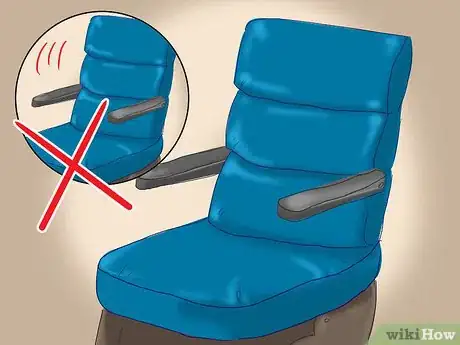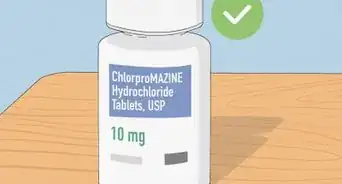This article was co-authored by Erik Kramer, DO, MPH. Dr. Erik Kramer is a Board-Certified Primary Care Physician at the University of Colorado. With over 15 years of experience, his clinical interests include obesity and weight management, diabetes care, and preventive care, as well as embracing a holistic approach to primary care. He received his Doctorate in Osteopathic Medicine (D.O.) from the Touro University Nevada College of Osteopathic Medicine and completed his residency at Central Maine Medical Center. Dr. Kramer is a Diplomate of the American Board of Obesity Medicine.
There are 11 references cited in this article, which can be found at the bottom of the page.
wikiHow marks an article as reader-approved once it receives enough positive feedback. In this case, 93% of readers who voted found the article helpful, earning it our reader-approved status.
This article has been viewed 94,777 times.
Seasickness or "mal de mer" is a common type of motion sickness caused by a disturbance in the inner ear due to repeated motions, such as the rising and falling of a boat while on water.[1] Common symptoms include dizziness, nausea, sweating, stomach cramps, and vomiting. Anyone can theoretically develop seasickness, but some people have a much greater sensitivity to motion due to their physiology, health status, or prescription medications they are taking. Medication can help to combat the symptoms, although there are also some practical ways of avoiding or reducing the likelihood of seasickness.
Steps
Natural Remedies
-
1Be careful what you eat and drink before going on a boat. Before boarding any boat, big or small, try to avoid consuming things that are likely to make your seasickness and nausea worse. This includes things like alcohol, caffeine, fatty foods, and spicy foods.[2] Heavy, greasy meals contribute to the development of nausea, which will be worsened by the motion on the water. That being said, it's important not to travel/sail on an empty stomach either. Focus on drinking lots of purified water and eating small portions of low-fat, bland, starchy foods, such as crackers, low-acid fruit, and unseasoned vegetables.[3]
- Sea sickness most commonly affects children (ages 2-12), pregnant or menstruating women, and migraine sufferers.[4]
-
2Choose a seat associated with the least motion. When booking travel on a cruise ship or boarding any other decent-sized boat, try to get a berth or seat as close to the center point of the vessel as possible, because that area will experience the least amount of motion.[5] Also try to get as close to the water as possible because the further away you get from the surface (the top decks of cruise ships, for example), the more motion you'll experience. In addition, try to seat yourself facing the direction of travel because you'll feel better orientated.
- Seasickness symptoms arise due to conflicting sensory information between the inner ear, eyes, and brain.[6] In essence, your brain thinks it's moving more than it actually is.
- Sailing on large cruise ships doesn't pose as many problems for people because of their relative lack of bobbing motion and use of automated stabilizers.
- To acclimate yourself aboard a cruise ship, it's best to spend some time out on a lower deck, using the horizon as a point to maintain your equilibrium.
- Having a window to look out will also give you a view of the horizon point.
Advertisement -
3Don't read while on a boat. Just like reading while riding in a car, reading on a boat can increase your risk of getting sea sick.[7] When your eyes are focused on a still object right in front of you, the rocking motions of the boat will send a conflicting message to your brain, causing disorientation and nausea. To avoid this, don’t read books or magazines, look at your phone, or use a laptop or tablet while on a boat if you're sensitive to seasickness. Instead, keep your gaze fixed on the horizon or on another fixed point in the distance until your inner ears and brain better synchronize with each other in terms of movement.
- If you're very sensitive to seasickness but enjoy cruising, then book only port-intensive cruises with lots of stops and fewer days on the rougher open seas.
- Consider reading prior to getting on a boat because it can make you drowsy and more prone to sleep. Sleeping on a boat, if that's appropriate, can negate the effects of seasickness.
-
4Wear a specially designed wrist band. Some people find that acupressure can help relieve symptoms of sea sickness—especially pressure on the “P6 point” near the wrist. Buy a sea sickness bracelet that puts pressure on this point or gently massage your own wrist to relieve your symptoms.[8] The P6 point is about 1 inch (2.5 cm) above the crease of your wrist and is associated with controlling or reducing nausea. You can buy sea sickness bracelets or wrist bands for this purpose online, in a pharmacy, or at many travel stores.
- A new FDA-approved device for motion sickness, called the ReliefBand, uses a weak electrical current to stimulate the P6 point.[9]
- Alternatively, try simply stimulating the P6 point with your thumb when you begin to feel nauseous and see how it works.
- Clinical trials have yielded mixed results concerning the value of acupressure in general, so your results may differ significantly from others’.
-
5Try taking some ginger. Eating ginger is an old home remedy for nausea. Ginger spice is made from the root of the ginger plant—it has a pungent and zesty flavor. Ginger has a long history of being very effective in alleviating many types of gastrointestinal symptoms. Taking ginger may reduce the symptoms of motion sickness, such as dizziness, nausea, and vomiting.[10]
- Medicinally, ginger is most commonly taken as a capsule (dried), but eating it fresh or pickled works also. You can also eat ginger chews or candies or sip ginger tea.
- Take between 1 to 2 grams of ginger at least 30 minutes before boarding a boat in order to avoid or minimize nausea.
- Some studies suggest that ginger may be particularly effective in relieving nausea and vomiting during pregnancy, and it is safer than many anti-nausea medications.[11]
Medications
-
1Try over-the-counter antihistamines. Antihistamines are a common remedy for sea sickness and other forms of motion sickness, and they’re easy to get in most drug stores.[12] Antihistamines work by influencing the part of the brain that controls nausea and vomiting. The most common ones used for sea sickness include dimenhydrinate (Dramamine), cyclizine (Marezine), diphenhydramine (Benadryl), promethazine (Phenergan), and meclizine (Antivert).
- Non-sedating antihistamines appear to be less effective, and besides, you may actually want to sleep your time away while on a boat.[13] Promethazine causes the most sleepiness, whereas meclizine (also used to treat vertigo) is less sedating and can be taken as a single daily dose.
- These medications are most effective when taken prior to boarding a boat and less effective for symptom relief after the sea sickness has begun.
-
2Ask your doctor about prescription anticholinergics. Anticholinergics are another class of drugs commonly used to combat motion sickness. They work by slowing down the messages related to the involuntary nervous system that go back and forth between the brain, inner ears, and eyes.[14] Scopolamine (Transderm-Scop) is the best-known anticholinergic and is available as a skin patch meant to be applied behind your ear at least 4 hours before boarding a boat. Its effectiveness for nausea prevention can last for up to 3 days.[15]
- Common side effects of scopolamine are the same as those of antihistamines (drowsiness, blurred vision, dry mouth, and confusion).
- In rare cases, these medications can cause more severe side effects, such as hallucinations, paranoia, or eye problems. Talk to your doctor about your health history and any other medications you are currently taking, since this can affect whether anticholinergics are safe for you.
- Other prescription medications sometimes used to manage sea sickness include: antidopaminergics (promethazine and metoclopramide), amphetamines, and benzodiazepines (Xanax and Valium).
-
3Ask your doctor what drugs may cause or worsen nausea. Some prescription drugs commonly cause nausea in sensitive users, so it's important to realize if yours are on that list. If they are and you're planning on a cruise or just going boating for the day, ask your doctor if you can discontinue or reduce the dose over the short-term. For example, some antidepressants, oral contraceptives, antibiotics (erythromycin), anti-parasitics, and narcotics (codeine) are known to worsen nausea.[16] However, never change doses of prescription medication without your doctor's approval.
- If you are taking prescription medications, avoid mixing them with alcohol, particularly while on a boat.
- Over-the-counter anti-inflammatories, such as ibuprofen and naproxen, can also worsen the effects of motion sickness.
Warning
- If your symptoms worsen or do not go away after returning to shore, seek medical attention as it could be an indication of a more serious condition.
References
- ↑ https://oceanservice.noaa.gov/facts/seasickness.html
- ↑ https://www.bbc.com/future/article/20160818-how-do-you-beat-seasickness
- ↑ https://my.clevelandclinic.org/health/articles/12782-motion-sickness
- ↑ https://wwwnc.cdc.gov/travel/yellowbook/2020/travel-by-air-land-sea/motion-sickness
- ↑ https://my.clevelandclinic.org/health/articles/12782-motion-sickness
- ↑ https://oceanservice.noaa.gov/facts/seasickness.html
- ↑ https://my.clevelandclinic.org/health/articles/12782-motion-sickness
- ↑ https://www.nytimes.com/2014/03/16/travel/prone-to-seasickness-distraction-might-help.html
- ↑ https://www.accessdata.fda.gov/cdrh_docs/pdf18/K182960.pdf
- ↑ https://www.nytimes.com/2014/03/16/travel/prone-to-seasickness-distraction-might-help.html
- ↑ http://www.ncbi.nlm.nih.gov/pubmed/15802416
- ↑ https://wwwnc.cdc.gov/travel/yellowbook/2020/travel-by-air-land-sea/motion-sickness
- ↑ https://www.aafp.org/afp/2014/0701/p41.html
- ↑ http://www.mayoclinic.org/drugs-supplements/anticholinergics-and-antispasmodics-oral-route-parenteral-route-rectal-route-transdermal-route/description/drg-20070312
- ↑ https://medlineplus.gov/druginfo/meds/a682509.html
- ↑ https://www.uofmhealth.org/health-library/sig56596
About This Article
A good way to avoid sea sickness is to prepare your stomach before you go on a boat by drinking lots of purified water. In addition to staying hydrated, eat small portions of low-fat, high-protein foods like grilled turkey or legumes. Some foods will make sea sickness worse, so avoid alcohol, caffeine, greasy foods, and spicy foods. You might think that an empty stomach will prevent any nausea, but, in fact, not eating anything can make it worse. If you’re having trouble eating, try munching on some flavorless crackers, like saltines. Once you’re on the boat, try to sit as close to the center point of the vessel as possible, because that area will experience the least amount of motion. You should also be as close to the water as possible since higher up areas like the top deck will be moving around more. For more advice from our Medical co-author, like how to take medication for sea sickness, scroll down!











-Step-9-Version-5.webp)





















-Step-9-Version-5.webp)



































Medical Disclaimer
The content of this article is not intended to be a substitute for professional medical advice, examination, diagnosis, or treatment. You should always contact your doctor or other qualified healthcare professional before starting, changing, or stopping any kind of health treatment.
Read More...